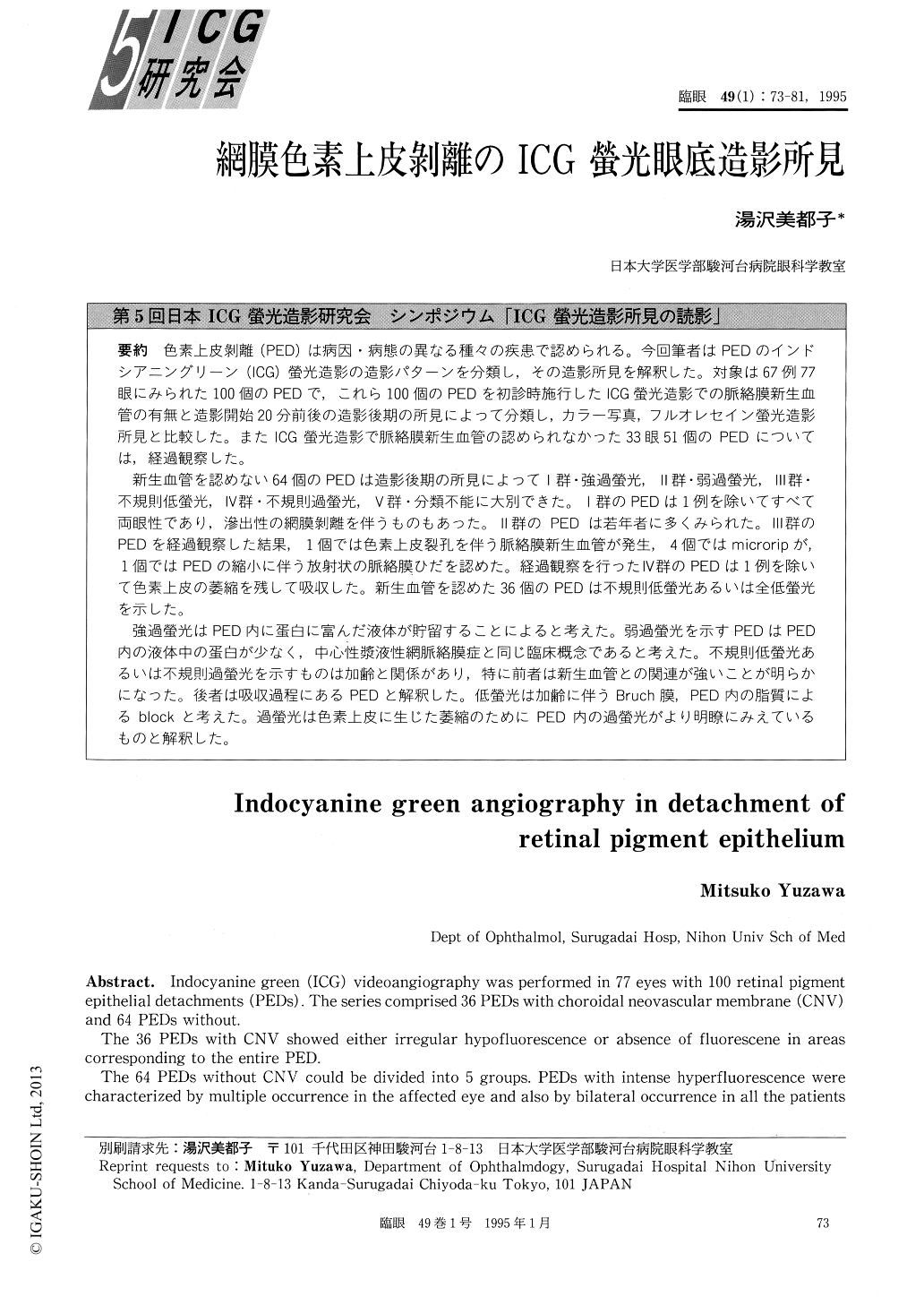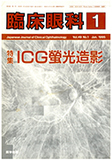Japanese
English
- 有料閲覧
- Abstract 文献概要
- 1ページ目 Look Inside
色素上皮剥離(PED)は病因・病態の異なる種々の疾患で認められる。今回筆者はPEDのインドシアニングリーン(ICG)螢光造影の造影パターンを分類し,その造影所見を解釈した。対象は67例77眼にみられた100個のPEDで,これら100個のPEDを初診時施行したICG螢光造影での脈絡膜新生血管の有無と造影開始20分前後の造影後期の所見によって分類し,カラー写真,フルオレセイン螢光造影所見と比較した。またICG螢光造影で脈絡膜新生血管の認められなかった33眼51個のPEDについては,経過観察した。
新生血管を認めない64個のPEDは造影後期の所見によってⅠ群・強過螢光,Ⅱ群・弱過螢光,Ⅲ群・不規則低螢光,Ⅳ群・不規則過螢光,Ⅴ群・分類不能に大別できた。Ⅰ群のPEDは1例を除いてすべて両眼性であり,滲出性の網膜剥離を伴うものもあった。Ⅱ群のPEDは若年者に多くみられた。Ⅲ群のPEDを経過観察した結果,1個では色素上皮裂孔を伴う脈絡膜新生血管が発生,4個ではmicroripが,1個ではPEDの縮小に伴う放射状の脈絡膜ひだを認めた。経過観察を行ったⅣ群のPEDは1例を除いて色素上皮の萎縮を残して吸収した。新生血管を認めた36個のPEDは不規則低螢光あるいは全低螢光を示した。
強過螢光はPED内に蛋白に富んだ液体が貯留することによると考えた。弱過螢光を示すPEDはPED内の液体中の蛋白が少なく,中心性漿液性網脈絡膜症と同じ臨床概念であると考えた。不規則低螢光あるいは不規則過螢光を示すものは加齢と関係があり,特に前者は新生血管との関連が強いことが明らかになった。後者は吸収過程にあるPEDと解釈した。低螢光は加齢に伴うBruch膜,PED内の脂質によるblockと考えた。過螢光は色素上皮に生じた萎縮のためにPED内の過螢光がより明瞭にみえているものと解釈した。
Indocyanine green (ICG) videoangiography was performed in 77 eyes with 100 retinal pigment epithelial detachments (PEDs). The series comprised 36 PEDs with choroidal neovascular membrane (CNV) and 64 PEDs without.
The 36 PEDs with CNV showed either irregular hypofluorescence or absence of fluorescene in areas corresponding to the entire PED.
The 64 PEDs without CNV could be divided into 5 groups. PEDs with intense hyperfluorescence were characterized by multiple occurrence in the affected eye and also by bilateral occurrence in all the patientsexcept one. Less intense hyperfluorescence was more common in younger subjects.
During follow-up eyes with PEDs that showed irregular hypofluorescence, CNV developed in 1 eye, microrips in 4 and retinochoroidal folds in 1. A mojority of PEDs showing irregular hyperfluorescence pattern turned later into atrophy of the retinal pigment epithelium.
The intense pattern is thought to be due to accumulation of protein-rich fluid within the PED. Most PEDs showing weak fluorescence would fall into the same entity as central serous choroidopathy. PEDs showing irregular hypofluorescence or hyperfluorescence are associated with age-related macular degeneration, especially, the former is closely related with CNV. Irregular hypofluorescence is thought to be due to the concentration or distribution of lipid within Bruch's membrane and/or the subpigment epithelial space. PEDs showing irregular hyperfluorescence are in the absorbing process. Hyperfluorescent areas correspond to areas of degeneration of the overlying retinal pigment epithelium.

Copyright © 1995, Igaku-Shoin Ltd. All rights reserved.


